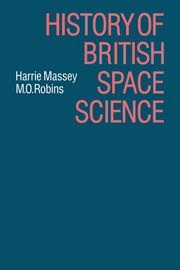Book contents
- Frontmatter
- Contents
- Glossary of abbreviations in text and annexes
- Glossary of abbreviations in appendices
- Preface
- 1 The scientific background
- 2 The technical background
- 3 The initiation of the Skylark rocket programme – the IGY and artificial satellites
- 4 Post-IGY developments – NASA – COSPAR – British National Committee for Space Research – British satellite experiments
- 5 The Ariel programme
- 6 The European Space Research Organization
- 7 Commonwealth co-operation in space reseach
- 8 Smaller rockets for scientific purposes – Skua and Petrel
- 9 Attitude controlled Skylark rockets
- 10 The Trend Committee and the Science Research Council
- 11 The transformation of ESRO into ESA
- 12 The Space Science Committee for Europe
- 13 Scientific studies by British space scientists – figure of the earth and the neutral atmosphere
- 14 Scientific studies by British space scientists – the ionosphere, the magnetosphere and cosmic rays
- 15 The contribution from British space scientists to astronomy
- 16 Concluding remarks
- Appendices
- Annexes
- Notes
- Index
11 - The transformation of ESRO into ESA
Published online by Cambridge University Press: 05 February 2012
- Frontmatter
- Contents
- Glossary of abbreviations in text and annexes
- Glossary of abbreviations in appendices
- Preface
- 1 The scientific background
- 2 The technical background
- 3 The initiation of the Skylark rocket programme – the IGY and artificial satellites
- 4 Post-IGY developments – NASA – COSPAR – British National Committee for Space Research – British satellite experiments
- 5 The Ariel programme
- 6 The European Space Research Organization
- 7 Commonwealth co-operation in space reseach
- 8 Smaller rockets for scientific purposes – Skua and Petrel
- 9 Attitude controlled Skylark rockets
- 10 The Trend Committee and the Science Research Council
- 11 The transformation of ESRO into ESA
- 12 The Space Science Committee for Europe
- 13 Scientific studies by British space scientists – figure of the earth and the neutral atmosphere
- 14 Scientific studies by British space scientists – the ionosphere, the magnetosphere and cosmic rays
- 15 The contribution from British space scientists to astronomy
- 16 Concluding remarks
- Appendices
- Annexes
- Notes
- Index
Summary
In Chapter 6 we recounted the steps which led to the establishment of ESRO as an organization for the support of European space scientists by the cooperative provision of most, but not all, of the technological facilities, project management services and contractual services needed in the 1960s. In so far as the vertical sounding rocket and scientific satellite programmes were successful, bearing comparison with any contemporary similar activities elsewhere, ESRO was very successful. But on a broader basis, there was by 1968 much dissatisfaction both among the space scientists making use of ESRO facilities, and amongst the member States providing the funds. Many scientists were critical of what they believed to be poor value for money, although these criticisms were not always easy to substantiate because of uncertain subsidies supporting alternative ways of proceeding. Governments tended to look critically at the build-up by ESRO of expensive technical and engineering facilities which clearly could be of great value to co-operative European programmes in applied space technology, whereas their restriction to the ESRO programmes of space science alone could, it was believed, lead to under-utilization and expensive duplication. In the background the faltering progress of ELDO, the desire of many Europeans to see a comprehensive space capability in Europe, including European satellite launching rockets, and the ever-present industrial and commercial interests in exploiting a new and potentially powerful technology, all contributed to a very confused scene in the late 1960s.
- Type
- Chapter
- Information
- History of British Space Science , pp. 225 - 243Publisher: Cambridge University PressPrint publication year: 1986



